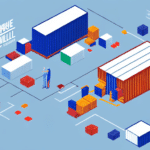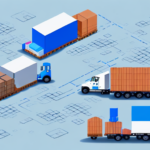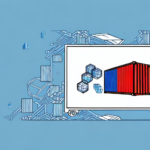The Benefits of Devanning in Supply Chain Management
Supply chain management is an intricate process that requires coordination across many moving parts. Devanning, also known as unloading, plays a significant role in efficient and cost-effective supply chain management. It involves the unpacking of goods from shipping containers or vehicles and organizing them for distribution throughout the supply chain. In this article, we explore the benefits of devanning in supply chain management and how it can help optimize your warehousing operations for smoother and faster delivery of goods to your customers.
Understanding Devanning: What It Is and How It Works
Devanning is the process by which shipping containers or vehicles are unloaded for the purpose of redistributing or storing the goods. The process involves unpacking the containers and organizing the goods according to their intended destination. This includes inspecting, sorting, and inventorying the goods, often using automation technology to quickly identify and track products. Devanning is a critical step in the supply chain that enables goods to be processed quickly and efficiently, minimizing downtime and reducing the likelihood of errors.
One of the key benefits of devanning is the more efficient use of warehouse space. By unpacking and organizing goods, warehouse managers can optimize the layout of their facilities and ensure that products are stored in the most appropriate locations. This can help reduce the time and effort required to locate and retrieve goods, as well as minimize the risk of damage or loss during storage. Additionally, devanning improves supply chain visibility by providing real-time information about the location and status of products, which can inform decision-making and enhance overall efficiency.
The Role of Devanning in Efficient Supply Chain Management
Efficient supply chain management is critical for businesses that want to keep up with customer demands and remain competitive. Devanning plays a vital role in this process by enabling the quick transfer of goods from one location to another. An optimized devanning process ensures that goods can be unloaded efficiently and moved along the supply chain, reducing the time it takes for them to be processed and delivered to customers. Accurate and complete data captured during devanning can be used for tracking inventory, analyzing trends, and optimizing future supply chain strategies.
Furthermore, devanning helps reduce the risk of damage to goods during transportation. By carefully unloading and handling goods, the risk of damage is minimized, ensuring that products arrive at their destination in good condition. This not only improves customer satisfaction but also reduces costs associated with damaged goods and returns. Additionally, devanning enhances workplace safety by ensuring that goods are handled safely and efficiently, thereby reducing the risk of accidents and injuries.
The Different Types of Devanning Techniques and Their Benefits
Several types of devanning techniques can be utilized based on business needs and the types of goods being transported:
- Manual Devanning: Involves the use of human labor to unpack containers.
- Automated Devanning: Utilizes machines and technologies to unload and sort goods.
- Cross-Docking: Involves unloading goods from one truck and immediately loading them onto another for delivery to their final destination.
Automated devanning is typically faster, more efficient, and safer than manual devanning. It reduces the risk of errors and minimizes the amount of labor required for the unloading process. However, manual devanning can be more cost-effective for small or specialized shipments or for businesses that require a high level of accuracy when handling sensitive goods. The decision to use manual or automated devanning depends on factors such as the size of the shipment, type of goods, level of accuracy required, and available budget.
Cross-docking is often used for time-sensitive shipments or for businesses that need to quickly move goods from one location to another. This technique can be more efficient than traditional devanning methods as it eliminates the need for storage and reduces handling time.
Additionally, businesses can outsource their devanning needs to third-party logistics providers. These providers specialize in devanning and offer a range of services, including manual and automated devanning, cross-docking, and storage. Outsourcing devanning can be a cost-effective solution for businesses that do not have the resources or expertise to handle the unloading process in-house.
How Devanning Can Help Optimize Your Warehousing Operations
Devanning can optimize warehousing operations in several ways:
- Increased Processing Speed: Speeds up the unloading and sorting of goods.
- Reduced Logistical Errors: Minimizes mistakes in inventory management.
- Improved Delivery Times: Enhances the speed of order fulfillment.
By identifying and resolving issues or discrepancies with shipments quickly, businesses can ensure that goods reach customers faster. Proper devanning techniques help ensure timely and condition-safe deliveries, maximizing customer satisfaction and loyalty.
Moreover, devanning can lead to significant cost savings by maximizing warehouse space utilization and reducing the need for additional storage facilities. Efficient unloading and organizing reduce storage costs and minimize damage to goods, lowering expenses related to repairs or replacements.
Streamlining Your Supply Chain with Devanning Best Practices
Implementing devanning best practices can streamline supply chain operations by minimizing errors, speeding up the unloading process, and optimizing the use of labor and resources. Key best practices include:
- Organized Unloading Area: Ensure the unloading area is clean and well-organized.
- Technology Utilization: Use barcode scanners and RFID systems to automate inventory processes.
- Clear Communication: Maintain open communication across all parts of the supply chain.
- Proper Training: Train personnel thoroughly and equip them with necessary tools and safety gear.
- Tracking Systems: Implement tracking systems to monitor the progress of the devanning process.
By following these best practices, businesses can enhance their devanning processes, leading to improved supply chain management and overall operational efficiency.
The Cost Savings of Implementing Devanning in Your Logistics Strategy
Implementing devanning can lead to substantial cost savings in multiple ways:
- Labor Cost Reduction: Automation reduces the need for manual labor.
- Time Efficiency: Speeds up the unloading process, allowing for quicker turnaround.
- Error Minimization: Reduces shipping errors, decreasing costs associated with returns and replacements.
- Space Utilization: Maximizes warehouse space, reducing the need for additional storage facilities.
Additionally, devanning improves the efficiency of a business's logistics strategy by streamlining the unloading process, reducing the time it takes to move goods from the shipping container to the warehouse, and enhancing order fulfillment speed. This leads to increased customer satisfaction and repeat business. Effective inventory tracking also reduces the risk of lost or misplaced items, further contributing to cost savings and operational success.
Overcoming Common Challenges in Devanning Implementation
Implementing devanning can present several challenges, including:
- Inadequate Infrastructure: Lack of proper facilities can hinder efficient devanning.
- Labor Shortages: Difficulty in finding and retaining skilled personnel.
- Inefficient Workflow: Poorly designed processes can lead to delays and errors.
- Insufficient Automation: Limited access to automated technologies can slow down operations.
To overcome these challenges:
- Invest in Technology: Utilize automation technologies to minimize errors and speed up unloading.
- Enhance Infrastructure: Ensure facilities are equipped to support efficient workflows.
- Provide Training: Regularly train staff to handle equipment and machinery effectively.
- Implement Tracking Systems: Use tracking systems to monitor progress and identify bottlenecks.
By addressing these challenges with strategic planning and execution, businesses can ensure a smooth and efficient devanning process, leading to improved supply chain management and customer satisfaction.
Enhancing Customer Satisfaction with Improved Delivery Times through Devanning
Devanning significantly contributes to enhanced customer satisfaction by enabling faster delivery times and more accurate organizational processes. Efficient unloading and sorting of goods accelerate processing times and improve delivery speeds. In today's fast-paced business environment, where customer expectations for quick and reliable deliveries are high, devanning plays a crucial role in meeting these demands.
By ensuring timely and punctual deliveries, businesses can increase customer retention and encourage repeat business. Efficient and accurate supply chain management, facilitated by effective devanning, is key to maintaining a competitive edge and fostering strong customer relationships.
The Future of Supply Chain Management: Integrating Automation with Devanning Techniques
The future of supply chain management lies in the integration of automation technologies with devanning techniques to optimize operations. Automated systems enhance the accuracy and speed of devanning, minimizing errors and reducing the time required to process shipments. Technologies such as robotic arms, barcode scanning systems, reusable containers, and smart packing solutions are revolutionizing devanning processes.
Integrating these technologies with existing devanning techniques enables businesses to streamline their supply chains and optimize operational efficiency. According to a recent industry report, companies that adopt automation in devanning see a 30% increase in processing speed and a 25% reduction in operational costs. Embracing automation not only improves efficiency but also positions businesses to meet the evolving demands of the global market.
Conclusion
Devanning is a critical component of supply chain management, providing businesses with a fast, efficient, and cost-effective method for managing their logistical processes. Ranging from manual labor to fully automated systems, devanning techniques offer flexibility to suit various business needs and budgets. Implementing proper devanning techniques significantly contributes to efficient and accurate supply chain management, leading to enhanced customer satisfaction and loyalty.
As the supply chain landscape continues to evolve, the integration of automation with devanning techniques will play a pivotal role in driving operational efficiency and accuracy. Investing in advanced devanning processes is essential for businesses aiming to optimize their supply chains and maintain a competitive edge in the market.
For more insights on optimizing your supply chain management, visit our ShipScience Blog.






















